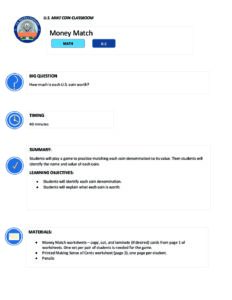Summary
Students review coin identification and learn the value of each coin.
Objectives
Students review coin identification and learn the value of each coin.
Subject Area
- Math
Grades
- K
- 1st
Class Time
- Total Time: 0-45 Minutes minutes
Materials
- Money Match worksheets – copy, cut, and laminate (if desired) cards from page 1 of worksheets. One set per pair of students is needed for the game.
- Printed 'Making Sense of Cents' worksheet (page 2), one page per student.
- Pencils
Lesson Steps
Review Coin Types and Introduce Game (10 minutes)
- Bring up images of circulating coins (penny, nickel, dime, quarter) from usmint.gov/kids or hold up examples of each coin.
- Ask the class to review the name of each coin and how much each one is worth.
- Explain that everyone will now get to practice identifying each coin and its value by playing a game.
Play Money Match and Complete Worksheet (40 minutes)
- Demonstrate the game for the entire class (see instructions below).
- Break students into groups of two. Give each pair one set of Money Match cards and each student a printed Making Sense of Cents worksheet.
- Allow 20 minutes to play the game.
- After 20 minutes has passed, ask students to stop playing and focus on the Making Sense of Cents worksheet. Remind them of the instructions: write in the name of each coin and then draw a line from each coin to its value. Allow them to work with their partner.
- After students have completed their worksheets, review the answers as a class.
How to Play "Money Match"
- Spread cards face down on floor, table, or desk.
- The first player turns over a coin card and a value card.
- If the coin and the value match, the player keeps the cards and takes another turn. Otherwise, he turns the cards back over in the same place.
- The second player takes a turn, repeating steps 2 and 3.
- Players take turns until all cards have been paired up and collected.
Differentiated Learning Options
Play another round of Money Match using coin combinations and corresponding values (e.g., two dimes and 20 cents).
Assess
Use the worksheets and class participation to assess whether the students have met the lesson objectives.
Common Core Standards
Discipline: Math
Domain: K.MD Measurement and Data
Grade(s): Grade K
Cluster: Describe and compare measurable attributes
Standards:
Discipline: Math Domain: K.MD Measurement and Data Grade(s): Grade K Cluster: Describe several measurable attributes of a single object Standards:
- K.MD.1. Describe measurable attributes of objects, such as length or weight.
- Describe several measurable attributes of a single object
Discipline: Math Domain: K.MD Measurement and Data Grade(s): Grade K Cluster: Describe several measurable attributes of a single object Standards:
- K.MD.2. Directly compare two objects with a measurable attribute in common, to see which object has "more of"/"less of" the attribute, and describe the difference. For example, directly compare the heights of two children and describe one child as taller/shorter.
- K.MD.3. Classify objects into given categories; count the numbers of objects in each category and sort the categories by count.
National Standards
Discipline: Mathematics
Domain: All Problem Solving
Cluster: Instructional programs from kindergarten through grade 12 should enable all students to
Grade(s): Grades K–12
Standards:
Discipline: Mathematics Domain: All Communication Cluster: Instructional programs from kindergarten through grade 12 should enable all students to Grade(s): Grades K–12 Standards:
- Build new mathematical knowledge through problem solving
- Solve problems that arise in mathematics and in other contexts
- Apply and adapt a variety of appropriate strategies to solve problems
- Monitor and reflect on the process of mathematical problem solving
Discipline: Mathematics Domain: All Communication Cluster: Instructional programs from kindergarten through grade 12 should enable all students to Grade(s): Grades K–12 Standards:
- organize and consolidate their mathematical thinking through communication
- communicate their mathematical thinking coherently and clearly to peers, teachers, and others;
- analyze and evaluate the mathematical thinking and strategies of others; and
- use the language of mathematics to express mathematical ideas precisely.
Subscribe to our
Lessons that Make Cents newsletter.

